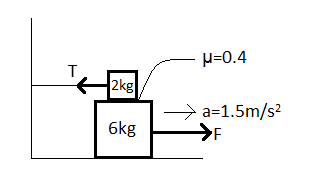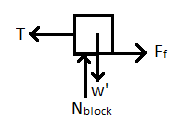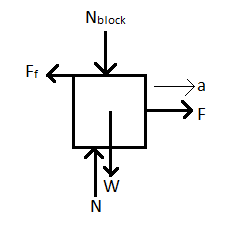Answer
397.5k+ views
Hint: This problem can be solved by drawing the proper free diagrams for both the blocks and then writing the force acceleration equations. By doing so for both the blocks, we will get a numerical expression for the force required to displace the larger block with the required acceleration.
Formula used:
$F=ma$
${{F}_{f}}=\mu N$
Complete step by step answer:
First let us draw a complete diagram to understand the problem better.

Now, let us analyze the question.
The mass of the smaller block is $m=2kg$.
Therefore, the weight of the smaller block is $w'=mg=2\times 10=20N$.
Let the force of the tension acting on the smaller block from the rope be $T$.
The coefficient of friction between the block surfaces is $\mu =0.4$.
Let the normal force exerted by the larger block on the smaller block be ${{N}_{block}}$ upward.
The smaller block applies this same normal force downward upon the larger block.
The mass of the larger block is $M=6kg$.
Therefore, the weight of the larger block is $W=Mg=6\times 10=60N$.
Let a force $F$ be acting on the larger block in the direction shown, such that it is pulled out with an acceleration of $a=1.5m/{{s}^{2}}$
In this case, the acceleration of the smaller block will be $a'=0$, since it is tied to the vertical wall.
Let the normal force from the ground on the larger block be $N$.
Let the force of friction between the blocks be ${{F}_{f}}$.
This will be towards the left hand side for the bigger block as its surface in contact with the other block is trying to move towards the right and friction will try to oppose this relative motion. On the smaller block it will be towards the right as its lower surface in contact with the bigger block is trying to move to the left relative to it.
Now, the force of friction ${{F}_{f}}$ on a body from a surface with coefficient of friction $\mu $ is given by
${{F}_{f}}=\mu N$ --(1)
Where $N$ is the normal force that the body exerts on the surface.
Therefore, using (1), we get
${{F}_{f}}=\mu {{N}_{block}}$ --(2)
Now, the total external force $F$ in one direction on a body of mass $m$ and the acceleration $a$ produced due to it is given by
$F=ma$ --(3)
Let us draw the free body diagram of the smaller block.

Since, the smaller block is at equilibrium using the free body diagram of the smaller block and (3), we will equate the forces in the vertical direction by considering upward forces as positive.
${{N}_{block}}-w'=m\left( 0 \right)=0$
$\therefore {{N}_{block}}=w'=20N$ --(4)
Putting (4) in (2), we get
${{F}_{f}}=0.4\times 20=8N$ --(5)
Now, let us draw the free body diagram of the bigger block.

Now, let us consider the forces in the horizontal direction. Therefore, using (3) and considering forces towards the right as positive, we get
$F-{{F}_{f}}=Ma$
$\therefore F={{F}_{f}}+Ma$
Putting (5) in the above equation, we get
$F=8+6\left( 1.5 \right)=8+9=17N$
Therefore, the required magnitude of the force is $17N$.
Therefore, the correct option is $A)\text{ }17N$.
Note: Students sometimes make the mistake of considering both the blocks together as a system for this problem and using the force acceleration equation on the whole system, try to get the required answer. However, they must realize that the smaller block does not have any acceleration, and is in equilibrium whereas the larger block moves. Since they do not have the same acceleration, they cannot be considered to be one system to apply the force acceleration equations.
Formula used:
$F=ma$
${{F}_{f}}=\mu N$
Complete step by step answer:
First let us draw a complete diagram to understand the problem better.

Now, let us analyze the question.
The mass of the smaller block is $m=2kg$.
Therefore, the weight of the smaller block is $w'=mg=2\times 10=20N$.
Let the force of the tension acting on the smaller block from the rope be $T$.
The coefficient of friction between the block surfaces is $\mu =0.4$.
Let the normal force exerted by the larger block on the smaller block be ${{N}_{block}}$ upward.
The smaller block applies this same normal force downward upon the larger block.
The mass of the larger block is $M=6kg$.
Therefore, the weight of the larger block is $W=Mg=6\times 10=60N$.
Let a force $F$ be acting on the larger block in the direction shown, such that it is pulled out with an acceleration of $a=1.5m/{{s}^{2}}$
In this case, the acceleration of the smaller block will be $a'=0$, since it is tied to the vertical wall.
Let the normal force from the ground on the larger block be $N$.
Let the force of friction between the blocks be ${{F}_{f}}$.
This will be towards the left hand side for the bigger block as its surface in contact with the other block is trying to move towards the right and friction will try to oppose this relative motion. On the smaller block it will be towards the right as its lower surface in contact with the bigger block is trying to move to the left relative to it.
Now, the force of friction ${{F}_{f}}$ on a body from a surface with coefficient of friction $\mu $ is given by
${{F}_{f}}=\mu N$ --(1)
Where $N$ is the normal force that the body exerts on the surface.
Therefore, using (1), we get
${{F}_{f}}=\mu {{N}_{block}}$ --(2)
Now, the total external force $F$ in one direction on a body of mass $m$ and the acceleration $a$ produced due to it is given by
$F=ma$ --(3)
Let us draw the free body diagram of the smaller block.

Since, the smaller block is at equilibrium using the free body diagram of the smaller block and (3), we will equate the forces in the vertical direction by considering upward forces as positive.
${{N}_{block}}-w'=m\left( 0 \right)=0$
$\therefore {{N}_{block}}=w'=20N$ --(4)
Putting (4) in (2), we get
${{F}_{f}}=0.4\times 20=8N$ --(5)
Now, let us draw the free body diagram of the bigger block.

Now, let us consider the forces in the horizontal direction. Therefore, using (3) and considering forces towards the right as positive, we get
$F-{{F}_{f}}=Ma$
$\therefore F={{F}_{f}}+Ma$
Putting (5) in the above equation, we get
$F=8+6\left( 1.5 \right)=8+9=17N$
Therefore, the required magnitude of the force is $17N$.
Therefore, the correct option is $A)\text{ }17N$.
Note: Students sometimes make the mistake of considering both the blocks together as a system for this problem and using the force acceleration equation on the whole system, try to get the required answer. However, they must realize that the smaller block does not have any acceleration, and is in equilibrium whereas the larger block moves. Since they do not have the same acceleration, they cannot be considered to be one system to apply the force acceleration equations.
Recently Updated Pages
Assertion The resistivity of a semiconductor increases class 13 physics CBSE

The branch of science which deals with nature and natural class 10 physics CBSE

What is the stopping potential when the metal with class 12 physics JEE_Main

The momentum of a photon is 2 times 10 16gm cmsec Its class 12 physics JEE_Main

How do you arrange NH4 + BF3 H2O C2H2 in increasing class 11 chemistry CBSE

Is H mCT and q mCT the same thing If so which is more class 11 chemistry CBSE

Trending doubts
State the differences between manure and fertilize class 8 biology CBSE

Why are xylem and phloem called complex tissues aBoth class 11 biology CBSE

Difference between Prokaryotic cell and Eukaryotic class 11 biology CBSE

Difference Between Plant Cell and Animal Cell

What would happen if plasma membrane ruptures or breaks class 11 biology CBSE

Give 10 examples for herbs , shrubs , climbers , creepers

What precautions do you take while observing the nucleus class 11 biology CBSE

What would happen to the life of a cell if there was class 11 biology CBSE

Change the following sentences into negative and interrogative class 10 english CBSE




